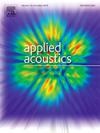Characterization and warning criteria of metro rail corrugation based on vibration and noise data fusion
IF 3.4
2区 物理与天体物理
Q1 ACOUSTICS
引用次数: 0
Abstract
Online monitoring of track conditions using commercial trains is pivotal for advancing intelligent railway maintenance. This study introduces a novel Corrugation Vibration-Noise Index (CVNI) based on vibration-noise data fusion to detect rail corrugation via train body dynamic responses. The correlation between train body vibrations, carriage interior noise, and rail corrugation is systematically analyzed, and the CVNI calculation process is derived. The effects of measurement point location, train type, track structure, and curve radius on CVNI are thoroughly investigated. Additionally, an Energy Coupling Index (ECI) is introduced as an auxiliary indicator for rail corrugation detection. A rail corrugation warning criterion based on CVNI is established and validated using field data. The results indicate that, under the same rail corrugation excitation, vertical vibration acceleration signals of the train body are more sensitive to short-wavelength corrugation of 40–60 mm, while carriage interior noise signals are more sensitive to medium-to-long wavelength corrugation of 160 mm. CVNI balances the Vibration Index (VI) and Noise Index (NI), demonstrating robust generalization across varying curve radii and track structures. The combined use of CVNI and ECI effectively mitigates low-frequency noise interference during low-speed operations and accurately identifies rail corrugation sections. When compared to traditional testing methods, the error is reduced to just 1.27 %.
求助全文
约1分钟内获得全文
求助全文
来源期刊

Applied Acoustics
物理-声学
CiteScore
7.40
自引率
11.80%
发文量
618
审稿时长
7.5 months
期刊介绍:
Since its launch in 1968, Applied Acoustics has been publishing high quality research papers providing state-of-the-art coverage of research findings for engineers and scientists involved in applications of acoustics in the widest sense.
Applied Acoustics looks not only at recent developments in the understanding of acoustics but also at ways of exploiting that understanding. The Journal aims to encourage the exchange of practical experience through publication and in so doing creates a fund of technological information that can be used for solving related problems. The presentation of information in graphical or tabular form is especially encouraged. If a report of a mathematical development is a necessary part of a paper it is important to ensure that it is there only as an integral part of a practical solution to a problem and is supported by data. Applied Acoustics encourages the exchange of practical experience in the following ways: • Complete Papers • Short Technical Notes • Review Articles; and thereby provides a wealth of technological information that can be used to solve related problems.
Manuscripts that address all fields of applications of acoustics ranging from medicine and NDT to the environment and buildings are welcome.
 求助内容:
求助内容: 应助结果提醒方式:
应助结果提醒方式:


